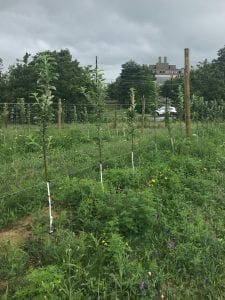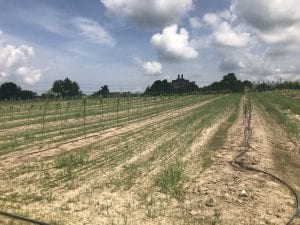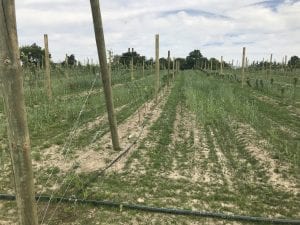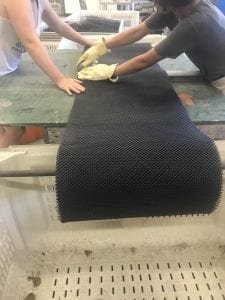While the Orchards Store has many tasty apples and cider for sale, much of my work with apples this summer has been on something that the store does not offer–hard cider apple varieties. The Orchards has multiple plantings of apples that might not taste the best if picked right from the tree, but, if given time, will make excellent hard ciders. These apples can make a variety of cider tastes, as each have differing levels of volatile compounds. The apple varieties I have worked with come from all across the world, like England’s Dabinette, United Kingdom’s Brown Snout, and the United State’s Golden Russet. The newest apples at the Orchards are from Spanish varieties, and have been a long work in progress, as many new varieties have to be quarantined before they are allowed to be planted.
When I first arrived at the Orchards, the staff had recently planted a new block of cider apples. These apples are different than the previous cider plantings, because the new block was planted with Spanish style cider varieties like Blanquina Geneva and Raxao Geneva. These new varieties of apples will produce a different tasting style of beverage than what is currently sold on the market. Draft magazine calls the Spanish cider style “funky, tart, smoky and sometimes challenging ciders.” Cider is often measured in terms of tannin and acidity, and hard ciders are often categorized as bittersweet (high tannin, low acidity), bittersharp (high tannin, high acidity), sharp (low tannin, high acidity), and sweet (low tannin, low acidity), depending on the content of each volatile. The Spanish style hard cider is made from apples with different levels of tannins and acidity, and most varieties have high acidity levels. It has been fun to see the progression of a new planting, and all the work that goes into planting an apple field. I’m eager to come back in future years and see how the fruit tastes, and learn firsthand how different the Spanish style is from the current style that is popular in the United States. In the mean time, here is the work I have been doing on the new planting.
At first, the trees looked very small and weak in this open field, but not for long!
The Orchards staff and my fellow interns got to work building trellising for the trees, so they could stand up in Ithaca’s weather. The wooden posts were pounded in with a special machine, and will support the trees throughout their lifespan.
Next, we painted the tree trunks white to prevent winter freeze injury, and then added rubber bands and clips to keep the trees in place. We also marked a certain height on the tree with red paint, so staff can go back in and measure the diameter of the trunks for research projects.
In this picture, we are cutting tree guards to keep out rabbits and other animals during the winter months and prevent damage to the trees.
Lots of work goes into planting and maintaining trees, but I’ve enjoyed working hands on with the new planting!



